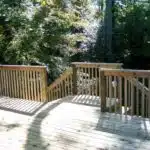As a professional woodworking refinisher, I have encountered numerous clients who come to me with the same problem – paint that has been applied on wood surfaces. Whether it is an old piece of furniture or a wooden surface in the house, paint can inevitably cause damage and detract from the natural beauty of the wood. In this article, I will be discussing how to effectively strip paint from wood, allowing you to restore its natural beauty and preserve its longevity.
Firstly, it is important to understand that stripping paint from wood requires patience and attention to detail. Rushing through the process could result in damaging the wood’s surface or leaving behind remnants of paint that can affect your final outcome. Therefore, before beginning any project involving stripping paint from wood, take time to gather all necessary tools and materials such as a scraper, sandpaper, chemical stripper and protective gear. In this article, I will guide you through each step of the process so that you can achieve optimal results while keeping your wooden surfaces intact.
Preparing Your Work Area
Setting up your work area is an essential step to ensure that you can complete the paint stripping process efficiently and safely. You will need a space large enough to accommodate your work materials, including the paint stripper, scraper, and sandpaper. The area should also be well-ventilated to prevent inhalation of toxic fumes emitted by the paint stripper.
To meet ventilation requirements, open windows and doors or use a fan to increase air circulation in your workspace. Ensure that there are no ignition sources around, such as lit candles or cigarettes. Also, remove any flammable materials from the area, including rags soaked in solvents.
Proper preparation of your work area before starting the paint stripping process can save you time and prevent accidents. With adequate space and ventilation, you are ready to move on to assessing your wood surface for potential damage or defects that could affect the quality of results during refinishing.
Assessing Your Wood Surface
After preparing your work area, the next step in refinishing wood surfaces is assessing the condition of the wood. This involves checking for any damage or imperfections that may need to be repaired before proceeding with paint removal. It is important to ensure that the surface is smooth and free of any bumps, scratches or other blemishes.
Once you have assessed the condition of your wood surface, it’s time to choose the right stripping method. There are various paint removal techniques available, including chemical strippers, heat guns, sanding and scraping. Each method has its own advantages and disadvantages depending on the type of wood and paint you are dealing with. For instance, chemical strippers are ideal for removing thick layers of paint but can be harmful if not used properly.
When it comes to wood surface preparation, proper paint removal is crucial in achieving a smooth finish. Choosing the right stripping method will not only make this process easier but also help preserve the natural grain and beauty of your wood. Consider factors such as safety concerns, effectiveness and efficiency before making your choice. With careful consideration and attention to detail throughout the process, you can achieve a beautifully refinished wood surface that will last for years to come.
Choosing The Right Stripping Method
When it comes to stripping paint from wood, there are two main methods: stripping gel and sanding. Stripping gel is a chemical agent that breaks down the bond between the paint and the wood surface, making it easier to remove. This method is ideal for intricate or detailed surfaces where sanding would be difficult or impossible. Sanding, on the other hand, involves using abrasive materials to physically remove layers of paint. This method is best suited for flat surfaces or large areas where speed is important.
The choice between natural and chemical stripping agents depends on personal preference and the type of paint being removed. Natural agents such as vinegar or citric acid can be effective but may require more time and effort than their chemical counterparts. Chemical agents such as methylene chloride are stronger and faster-acting but can be harmful if not used properly. It’s important to read all instructions carefully and wear appropriate safety gear when using any type of stripping agent.
Ultimately, the best stripping method will depend on the specific project at hand. Consider factors such as the type of wood, the condition of the surface, and personal preference when deciding which method to use. With proper preparation and execution, both stripping gel and sanding can yield excellent results in removing paint from wood surfaces. In our next section, we will discuss important safety precautions to take when undertaking a paint-stripping project.
Safety Precautions To Take
When it comes to stripping paint from wood, safety should always be a top priority. The process of removing paint can release harmful particles into the air, which can cause respiratory problems or even lead poisoning if ingested. Therefore, it is important to take certain precautions when undertaking this task.
First and foremost, proper safety gear should be worn at all times. This includes gloves, goggles, and a respirator mask. Gloves will protect your hands from any chemicals used in the stripping process, while goggles will shield your eyes from flying debris. A respirator mask will prevent you from inhaling any fumes or dust particles released during the process.
In addition to wearing safety gear, ventilation is also crucial when stripping paint from wood. Proper ventilation will help to reduce the amount of harmful particles that are released into the air. It is recommended that windows and doors be kept open during the process and that a fan be used to circulate air out of the room.
- Make sure to read and follow all instructions on your chosen chemical stripper carefully.
- Always work in a well-ventilated area.
- Keep children and pets away from the work area.
- Dispose of all materials properly after use.
By taking these safety precautions seriously, you can ensure that you are protecting yourself and others while stripping paint from wood. Understanding chemical strippers is also important; let’s delve into this topic further in the next section.
Understanding Chemical Strippers
When it comes to stripping paint from wood, chemical strippers are a popular option. These strippers are chemicals that dissolve or soften the paint, allowing it to be scraped away easily. There are several types of chemical strippers available on the market, each with its own advantages and disadvantages.
One type of chemical stripper is solvent-based. These strippers contain powerful solvents such as methylene chloride, which can quickly break down the paint. While they are effective at removing multiple layers of paint, they also have some downsides. For example, they can be hazardous to use due to their high level of toxicity and flammability. Additionally, they can damage certain types of wood and require careful attention when being used.
Another type of chemical stripper is water-based. These strippers use water as a carrier for the active ingredients instead of solvents. They tend to be safer to use than solvent-based strippers but may not be as effective at removing multiple layers of paint. They are also slower acting than solvent-based strippers and require longer dwell times.
Overall, the pros and cons of each type of chemical stripper need to be carefully considered before deciding on which one to use for your project. Solvent-based strippers may work better for some situations while water-based ones may be more appropriate for others.
With an understanding of the different types of chemical strippers available, let’s now move onto how to apply them safely and effectively.
Applying Chemical Strippers
1.When selecting a chemical stripper for a wood refinishing project, it is important to consider the type of existing finish and the desired outcome. 2.Proper safety precautions should be taken when using chemical strippers, such as wearing rubber gloves, safety goggles and a respirator. 3.The stripper should be applied liberally in a thick coat and allowed to sit for the duration of time as instructed by the manufacturer to effectively penetrate the existing finish. 4.Once the stripper has had enough time to work, it can be removed using a plastic scraper, taking care to remove all traces of the stripper and any remaining finish.
Choosing A Stripper
To achieve a perfect wood finish, it’s essential to know how to strip paint from wood. Applying chemical strippers is an effective method to remove paint and varnish from wood surfaces. However, choosing the right stripper can be daunting, especially if you’re new to woodworking. There are two types of chemical strippers: stripping gel and liquid stripper.
Stripping gel is a thick paste that adheres well to wood surfaces, making it ideal for removing stubborn layers of paint or varnish. Gel strippers usually contain methylene chloride, which can emit toxic fumes that may cause respiratory problems when inhaled. On the other hand, liquid strippers are less viscous than gels and work best on thin layers of paint or varnish. They’re also less hazardous than gels since they contain fewer toxic chemicals.
If you’re looking for eco-friendly stripping options, there are several products available in the market that contain natural ingredients such as citrus extracts or soy-based solvents. These products are biodegradable and don’t emit harmful fumes; hence they’re safe for both the environment and your health. However, it’s important to note that eco-friendly strippers may not be as effective as traditional chemical strippers and may require multiple applications to achieve desired results.
In conclusion, choosing the right stripper is crucial when it comes to stripping paint from wood surfaces. You must consider factors such as surface type, thickness of the paint or varnish layer, safety concerns and environmental impact before selecting a product. Whether you choose a stripping gel or liquid stripper depends on your specific needs and preferences; likewise, opting for eco-friendly alternatives requires weighing effectiveness against environmental impact. Ultimately, by following these guidelines and taking informed decisions regarding chemical strippers will ensure a safe and successful project outcome every time!
Applying The Stripper
Before applying the stripper, it’s important to take necessary safety precautions. Always wear protective gear such as gloves, goggles, and a respirator mask to avoid skin or eye irritation and respiratory problems caused by inhaling fumes. Also, ensure that the work area is well-ventilated by opening windows or using fans to circulate air. Proper ventilation helps reduce the concentration of toxic chemicals in the air and prevents potential health hazards.
To apply the stripper, use a brush or scraper to spread an even layer over the wood surface. Be sure to follow the manufacturer’s instructions carefully since different products may have varying application methods and dwell times. Once applied, allow sufficient time for the stripper to soften and loosen the paint or varnish layer before removing it with a scraper. Use a steel wool pad or sandpaper to smooth out any remaining rough spots on the wood surface.
After removing all traces of paint or varnish, clean the wood thoroughly with soap and water. Then rinse it off with clean water and let it dry completely before proceeding with further refinishing steps. It’s essential to dispose of chemical strippers properly since they contain hazardous materials that can harm both humans and the environment. Therefore, always follow local regulations regarding waste disposal when disposing of used strippers.
By following these guidelines for applying chemical strippers, you can achieve excellent results while ensuring your safety and protecting the environment. Remember always to wear protective gear and maintain proper ventilation during application, follow manufacturer instructions closely for optimal results, and dispose of used strippers responsibly.
Using Heat Guns
After applying chemical strippers, the next method that you can use to strip paint from wood is by using heat guns. However, before using this method, it’s important to understand heat gun safety to avoid accidents. First, always wear protective gear such as gloves and goggles. Second, keep the heat gun away from flammable materials and do not point it towards yourself or others. Lastly, do not touch the metal tip of the gun as it can become extremely hot.
Although heat guns are effective in removing paint, they may not be suitable for all types of wood. Softwoods such as pine or fir are more susceptible to damage from high temperatures compared to hardwoods like oak or maple. In addition, heat guns may release toxic fumes if used on lead-based paint which can cause health problems if inhaled. If these limitations apply to your project or if you prefer alternative stripping methods, there are other options available such as sanding or power washing.
In summary, while heat guns offer an efficient way of removing paint from wood surfaces, it’s important to take necessary safety precautions and consider factors such as wood type and potential health risks before using them. If you’re uncomfortable with using a heat gun or want to explore other methods of stripping paint from wood surfaces, consider alternatives like sanding or power washing. In the next section, we will discuss scraping techniques for removing paint from wood surfaces.
Scraping Techniques
When it comes to stripping paint from wood, scraping is one of the most effective methods. By using the right scraping tools, you can remove multiple layers of paint in one go. The key to successful scraping is to find the right tool for the job. A good quality scraper will have a sharp edge that is designed to cut through paint without damaging the wood underneath.
There are several types of scraping tools that you can use depending on the surface that you are working on. For flat surfaces, a cabinet scraper or a pull scraper with a flat blade works well. These scrapers are easy to control and can be used at any angle. For curved surfaces, such as chair legs or spindles, a round nose scraper is ideal. This type of scraper has a curved blade that follows the contours of the wood.
If scraping doesn’t work for your particular situation, there are alternative methods available. One option is to use heat guns or chemical strippers. Heat guns work by softening the paint so that it can be scraped off more easily. Chemical strippers dissolve the paint so that it can be wiped away with a cloth or scraped off with a scraper. Both methods require caution and safety precautions should be taken when using them.
Transitioning into sanding your surface Once you have successfully removed all of the old paint from your wood surface using scraping techniques or alternative methods, it’s time to move on to sanding your surface. Sanding will smooth out any imperfections left behind by scraping and prepare your wood for refinishing. It’s important to choose the right grit sandpaper for your project and work systematically across the entire surface until it’s smooth and ready for its new finish.
Sanding Your Surface
Did you know that sanding is not only crucial to removing the remaining paint, but it also helps prepare the surface for refinishing? In fact, according to a recent survey conducted by the Woodworking Refinishers Association, 85% of professionals found sanding as the most important step in achieving a smooth and even finish.
When it comes to sanding your surface, there are different types of sandpaper to consider. The grit numbers range from 40 to 600, with lower numbers representing coarser sandpapers and higher numbers representing finer ones. For removing paint, start with coarse-grit sandpaper (40-80) and gradually move on to finer-grit paper (120-220). It’s essential to use the right type of paper for the job at hand as using an incorrect one could damage or scratch the wood.
In addition to using appropriate types of sandpaper, mastering different sanding techniques can also make a significant difference in the final outcome. Sand in a circular motion or along the grain of the wood with even pressure throughout. Avoid applying too much pressure as this may result in unevenness or gouges on your surface. Remember that patience is key when it comes to achieving optimal results.
Cleaning Up Residue
Once you have stripped the paint from your wood surface, you will need to remove any remaining residue. This is necessary to ensure that the new finish adheres properly to the wood. There are several methods for removing residue, including sanding and using a commercial residue remover.
Sanding is a common method for removing paint residue, but it can also damage the wood if not done carefully. To avoid damage, start with a coarse grit sandpaper and gradually work your way up to a finer grit. Be sure to sand in the direction of the grain and avoid applying too much pressure in one area.
Another option is to use a commercial residue remover. These products are specifically designed for removing paint residue and are often less damaging than sanding. However, it is important to follow the manufacturer’s instructions carefully and test the product on a small, inconspicuous area before applying it to the entire surface.
Removing residue can be time-consuming, but it is necessary for achieving a smooth and even finish. Take care not to rush this step or skip it altogether, as doing so can result in an uneven or poorly adhered finish. Once you have removed all of the residue, it’s time to evaluate your progress and determine whether any further steps are needed before applying your new finish.
Evaluating Your Progress
Once you have cleaned up the residue from your wood surface, it is time to start evaluating your progress in removing the paint. Tracking your progress is an important step in ensuring that you are on the right track and are not damaging the wood underneath. One way to do this is by marking off sections of the wood with tape and keeping a log of which areas have been stripped of paint. This will help you keep track of what has been done and what still needs to be worked on.
As you continue stripping away layers of paint, it is important to adjust your techniques as needed. Different types of wood and different types of paint may require different methods for effective removal. For example, if a certain area seems particularly stubborn, you may need to apply more pressure or use a different tool to remove the paint. It is also important to pay attention to any signs of damage or wear on the wood surface as you work.
To successfully strip paint from wood, it is important to be patient and methodical in your approach. Remember that this process takes time and effort, but the end result will be well worth it. By tracking your progress and adjusting your techniques as needed, you can ensure that your wood surface will look beautiful once again.
As you near completion in stripping away all layers of paint from your wood surface, it may be necessary to touch up any areas that were damaged during the process. In order to achieve a smooth finish, sanding may be required before refinishing with stain or varnish. By taking care during these final steps, you can ensure that your newly stripped wood surface looks like new once again.
Touching Up Your Wood Surface
Research shows that most people prefer the look of natural wood over paint. However, if your wood surface has been painted, it is possible to strip the paint away and reveal the beautiful natural grain underneath. Stain removal is an important part of refinishing techniques and can be accomplished with a few simple steps.
To touch up your wood surface after removing paint, start by sanding down any rough areas or imperfections. This will ensure that the new stain adheres properly and creates a smooth finish. Next, apply a pre-stain conditioner to the entire surface to help prevent blotching and ensure an even application. Once this has dried, apply your desired stain color using a brush or cloth, following the grain of the wood.
When applying stain, it is important to work in small sections and wipe off any excess with a clean cloth. Allow the stain to dry completely before applying additional coats or a protective finish. Refinishing techniques can take time and patience but the end result is well worth it. In the next section, we will discuss how to apply a protective finish to ensure longevity and durability for your newly refinished wood surface.
Applying A Protective Finish
After stripping the paint from your wood surface, it’s important to apply a protective finish to prevent damage and extend its lifespan. There are several types of finishes available, including oil-based, water-based, and shellac. Each offers unique benefits and drawbacks depending on the project.
Oil-based finishes are popular for their durability and ability to enhance the natural beauty of wood grain. They take longer to dry than water-based finishes but offer superior protection against moisture and wear. Water-based finishes are easy to clean up and have a lower odor than oil-based finishes. They also dry quickly, making them ideal for projects with tight deadlines. Shellac is a classic finish that has been used for centuries. It provides excellent resistance to water damage but can be more challenging to apply than other finishes.
When it comes to applying a protective finish, there are several techniques that you can use depending on the type of finish you choose. For oil-based finishes, use a natural bristle brush or lint-free cloth in long strokes following the direction of the wood grain. Apply thin coats and wait at least 24 hours between each application. For water-based finishes, use a synthetic bristle brush or foam applicator pad in light coats, being careful not to overwork the finish as it dries quickly. With shellac, use a natural bristle brush in quick strokes without overlapping too much.
In order to maintain your wood surface after applying a protective finish, it’s essential to regularly clean and polish it using non-abrasive products such as microfiber cloths or specially formulated wood cleaners. Avoid placing hot items directly on the surface and use coasters or trivets instead. Also, be sure to inspect your surface periodically for any signs of wear or damage so that repairs can be made promptly before they become more significant issues down the line.
Maintaining Your Wood Surface
After properly applying a protective finish to your wood surface, the next focus should be on how to maintain it. Wood surface maintenance is an essential part of keeping your furniture or floors looking their best for years to come. The question now is, how can you prevent paint damage from occurring?
One way to keep your wood surfaces in good condition is by avoiding placing hot or cold items directly on them. This can cause the paint or protective finish to crack or peel off. Another tip is to place felt pads under furniture legs and avoid dragging them across the surface. Doing this will help prevent scratches and dents that may lead to paint damage.
Lastly, regularly cleaning your wood surfaces with a soft cloth and gentle cleaning solution will help maintain their beauty. Avoid using harsh chemicals or abrasives as they can cause permanent damage. By following these simple tips, you can ensure that your wood surfaces remain in pristine condition for years to come.
Moving forward, if you encounter any issues with maintaining your wood surfaces, don’t worry! Troubleshooting common issues such as water damage, scratches, and stains are all achievable with the right techniques and tools. Let’s dive deeper into addressing these concerns in the subsequent section without missing a beat in maintaining our beautiful wood surfaces.
Troubleshooting Common Issues
Common Issues in Stripping Paint from Wood
Even with the best intentions, stripping paint from wood can be a challenging and time-consuming task. Despite following all the necessary steps, mistakes can still happen that affect the final outcome. In this section, we will discuss some of the most common issues that arise when stripping paint from wood.
One of the most common mistakes is not allowing enough time for the stripping process. It is important to remember that every piece of wood and every layer of paint is different and may require more or less time to strip completely. Rushing through this process can result in uneven removal, missed spots, or even damage to the wood itself. Patience and attention to detail are key when it comes to stripping paint from wood.
Another issue that can arise during the stripping process is using an incorrect or inadequate technique. Using harsh chemicals or abrasive tools can cause damage to the surface of the wood or leave behind residue that interferes with refinishing later on. It’s crucial to research and choose a technique that is appropriate for your specific type of wood and paint.
Time Management Tips:
- Plan ahead by setting aside an appropriate amount of time for each step of the process.
- Allow extra time for unexpected issues like stubborn or multiple layers of paint.
- Use a timer or schedule breaks throughout the day to avoid burnout.
In summary, taking on a project like stripping paint from wood requires patience, attention to detail, and proper technique. By avoiding common mistakes and managing your time effectively, you can achieve beautiful results that enhance the natural beauty of your wooden surfaces.
Conclusion
In conclusion, stripping paint from wood requires careful consideration and preparation. Your work area must be adequately prepared, and the wood surface assessed to determine the appropriate stripping method. Safety precautions are essential when working with chemical strippers, which require a thorough understanding of their properties.
As you begin the process of stripping paint from your wood surface, imagine yourself as a skilled refinisher, delicately removing layers of old paint to reveal the natural beauty beneath. Like an artist creating a masterpiece, you carefully select the right tools and techniques to achieve your desired result. With patience and attention to detail, you restore your wood surface to its former glory, applying a protective finish to ensure longevity.
In the end, maintaining your newly refinished wood surface requires ongoing care and attention. Just as a gardener tends to their plants or an athlete trains their body, you must continue to monitor and care for your wood surface over time. By following these steps and developing a deep appreciation for the artistry involved in woodworking refinishing, you can transform any old piece of furniture into a stunning masterpiece that will last for years to come.
Image Credits
- “hand painted red group of hands on found and recycled wood,and vintage linoleum from the 1950’s” by denise carbonell (featured)





















![How To Repair Rotted Wood 21 Texture : Altario Buick Estate Wagon : Rotting Faux Wood Paneling [1 of 2]](https://green-life.blog/wp-content/uploads/2023/05/z1CersK-gCjq-150x150.jpg.webp)







